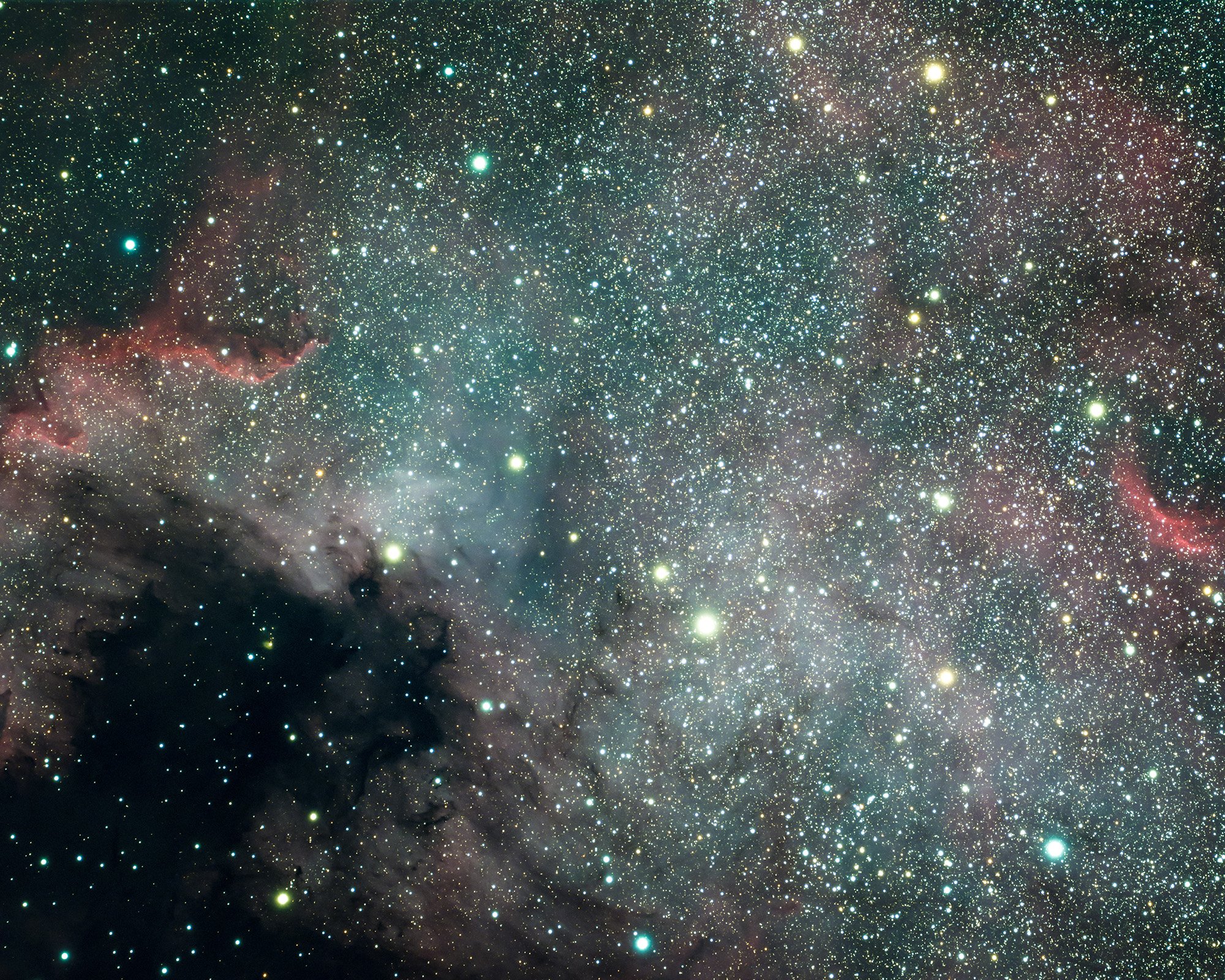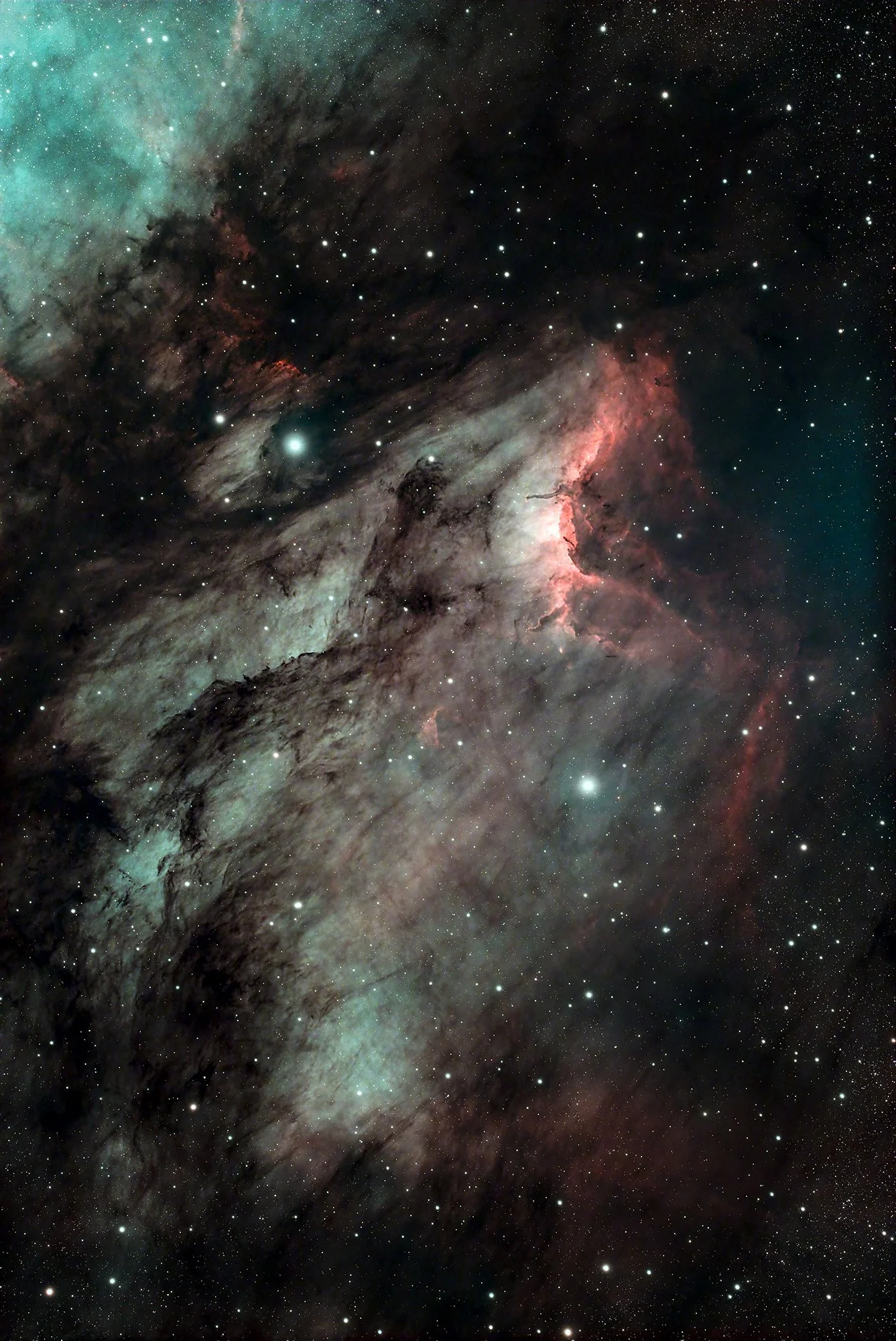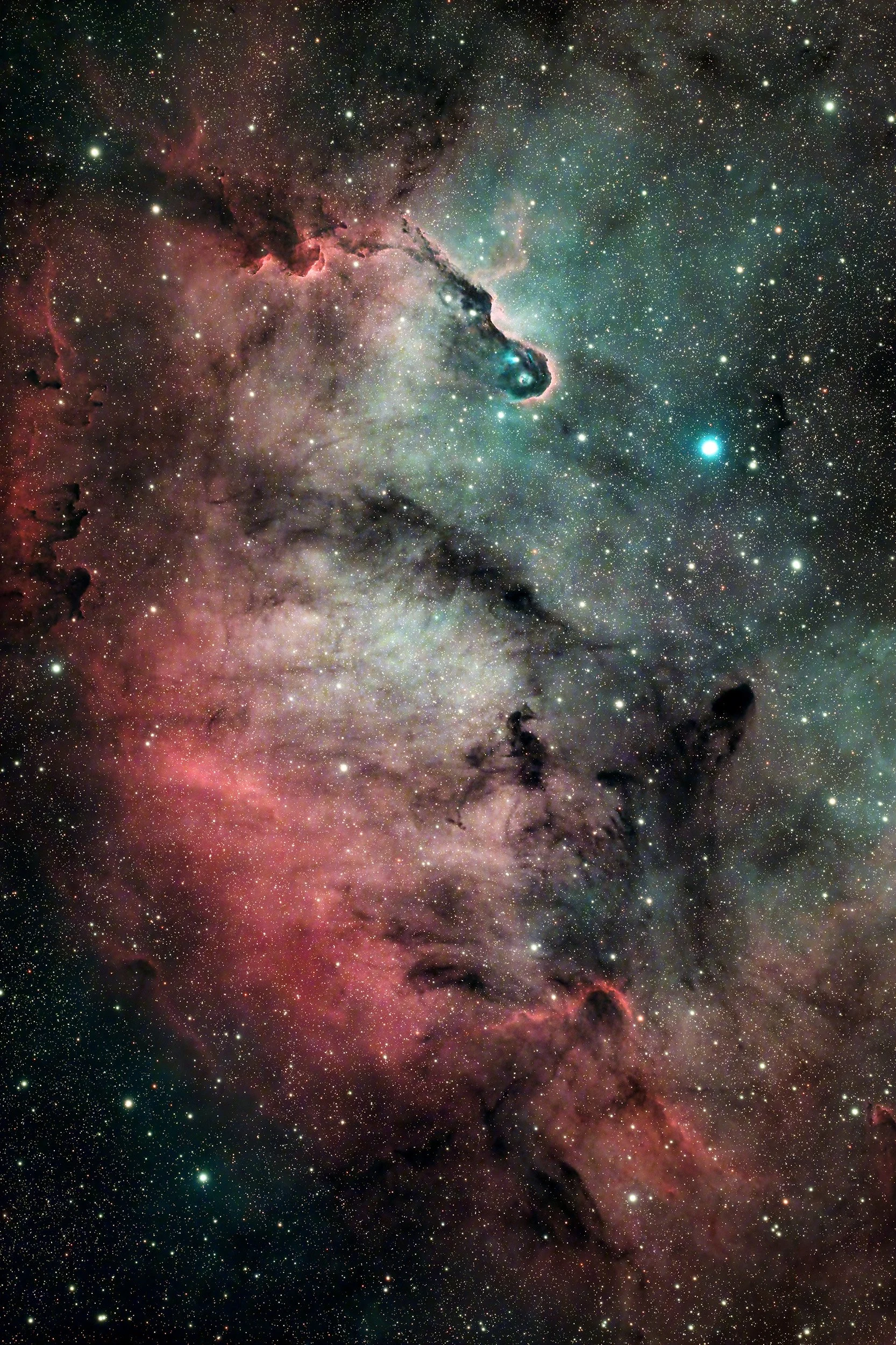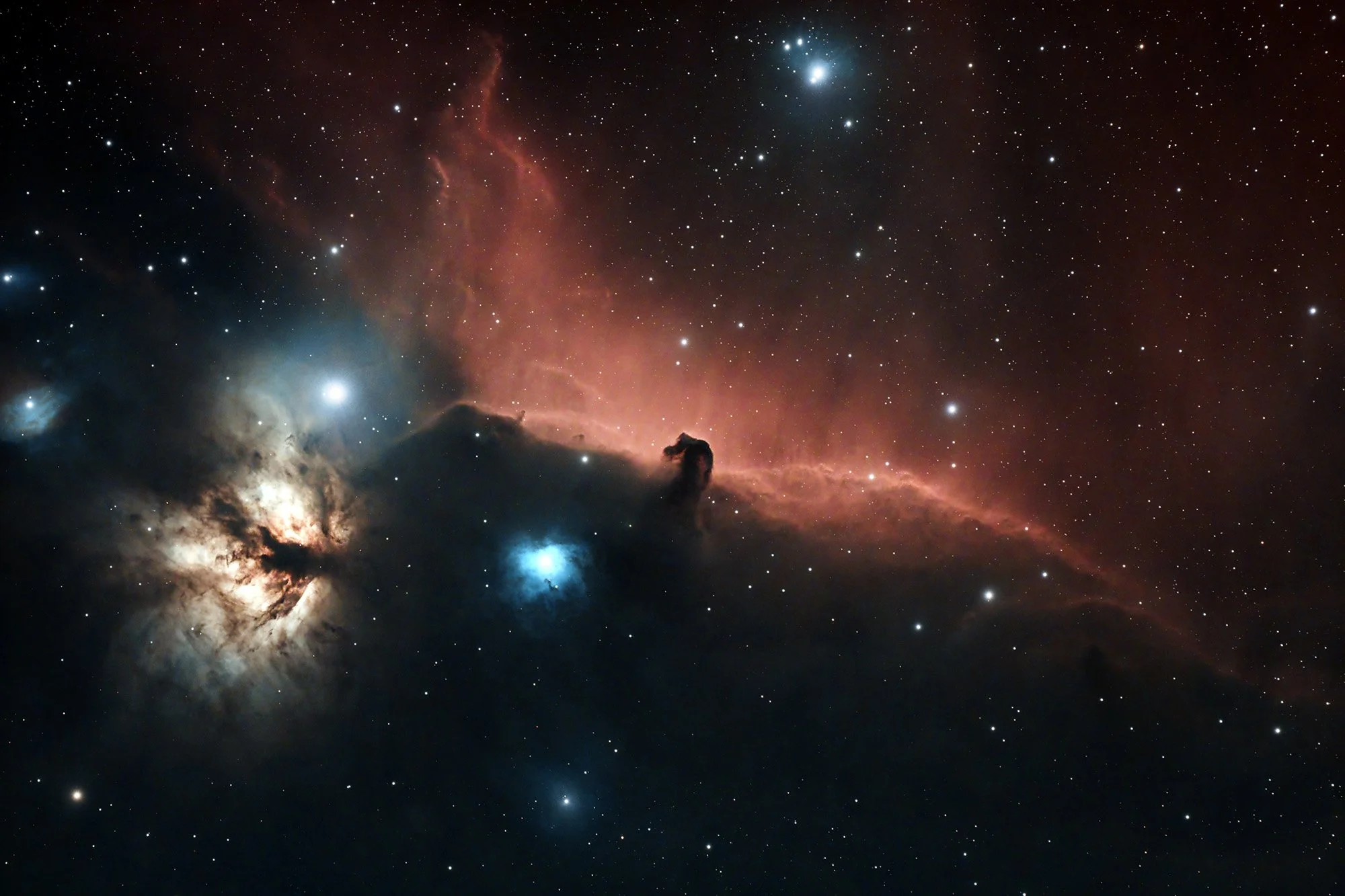
Western Veil Supernova

Pacman Nebula

Heart Nebula

A Portion of the North American Nebula

The Pleiades

Pelican Nebula

Elephant Trunk Nebula

Horsehead Nebula and Flame Nebula

Andromeda Galaxy

Orion Nebula

Triangulum Galaxy

Western Veil SupernovaThe Veil Nebula, also known as the Cygnus Loop, is a massive supernova remnant located in the constellation Cygnus. It is the expanding, delicate, and filamentary remains of a star that exploded roughly 10,000 years ago, a blast wave from which is still traveling through space and plowing into interstellar gas. The nebula is named for its resemblance to draped, wispy veils and is a complex of glowing gases containing hydrogen, oxygen, and sulfur. As a well-studied supernova remnant, the Veil Nebula provides a look at the aftermath of a massive stellar explosion and the subsequent creation of new stellar material.

Pacman NebulaThe Pacman Nebula, officially NGC 281, is a bright emission nebula in the constellation Cassiopeia, named for its resemblance to the video game character. This star-forming region is located in the Milky Way's Perseus Spiral Arm, approximately 9,200 light-years from Earth, and features dark dust lanes, like the prominent "mouth," along with young stars and dense Bok globules.

Heart NebulaThe Heart Nebula, officially known as IC 1805, is a star-forming region and emission nebula located about 7,500 light-years away in the constellation Cassiopeia. Named for its heart-like shape, it features a central open star cluster called Melotte 15, which is composed of young, massive stars that sculpt the surrounding clouds of gas and dust with their energetic winds and radiation.

A Portion of the North American NebulaThe North America Nebula (NGC 7000) is a large emission nebula in the constellation Cygnus, known for its striking resemblance to the continent of North America. Located about 2,600 light-years away, it is a vast cloud of hydrogen gas excited by the ultraviolet radiation from a hidden, hot star. The nebula is a popular target for astrophotographers and can also be viewed with a small telescope and a specialized filter under dark skies.

The PleiadesThe Pleiades, also known as the Seven Sisters, is a brilliant, open star cluster in the winter sky, located in the constellation of Taurus. The cluster contains several hundred stars, but most people only see six or seven with the naked eye. In Greek mythology, the stars are the seven daughters of the Titan Atlas and the nymph Pleione, who were transformed into stars to escape the hunter Orion. The Pleiades is also a significant star cluster in the folklore and cultures of peoples worldwide and is a popular target for astrophotographers.

Pelican NebulaThe Pelican Nebula is a star-forming emission nebula, cataloged as IC 5070, located in the constellation Cygnus about 1,800 light-years from Earth. It is characterized by a pelican-like shape formed by glowing, ionized gas clouds that are being transformed by the radiation from nearby young, massive stars. The nebula is part of a larger complex with the North America Nebula, separated by a dark cloud of dust.

Elephant Trunk NebulaThe Elephant's Trunk Nebula is a dense formation of interstellar gas and dust within the IC 1396 nebula in the constellation Cepheus, roughly 2,400 light-years from Earth. Its striking "trunk" shape, which resembles an elephant's head and trunk, is created by intense radiation from nearby massive stars that sculpt the dust and gas into a long, dark silhouette with a bright, compressed rim. This compressed region serves as a stellar nursery, with infrared images revealing hundreds of young stars forming within it.

Horsehead Nebula and Flame NebulaThe Horsehead Nebula is a dark cloud of gas and dust in the Orion constellation that blocks the light from a glowing emission nebula (IC 434) behind it, creating the iconic horse's head shape. Located about 1,400 light-years away, this well-known astronomical object is part of a star-forming region called the Orion Molecular Cloud Complex and is a popular target for astronomers to observe and photograph.

Andromeda GalaxyThe Andromeda Galaxy (M31) is the closest large spiral galaxy to our own Milky Way, located about 2.5 million light-years away. It is the largest galaxy in the Local Group and is visible to the naked eye as a faint, milky blur. Andromeda features a central bar and spiral arms, similar to the Milky Way, and plays a significant role in studying galactic evolution and the expanding nature of the universe.

Orion NebulaThe Orion Nebula (M42) is a star-forming region in the constellation Orion, about 1,350 to 1,500 light-years away, that is a vast cloud of gas and dust where thousands of new stars are being born. It is the closest and most well-known stellar nursery, visible as a fuzzy patch in the sky to the naked eye as part of Orion's sword. The nebula's center contains the Trapezium, a cluster of four young, hot stars that illuminate much of the surrounding gas and dust, revealing a magnificent web of glowing gas and dark dust where stars and planetary systems are forming.

Triangulum GalaxyThe Triangulum Galaxy (M33) is a nearby spiral galaxy, part of the Local Group along with the Milky Way and Andromeda Galaxy. Located about 3 million light-years away, it is the third-largest galaxy in the Local Group and contains numerous star-forming regions, neutron stars, and black holes, visible in X-ray data. Under very dark skies, it can even be seen with the naked eye.
info
prev / next
1
2
3
4
5
6
7
8
9
10
11
·
·
·
·
·
·
·
·
·
·
·